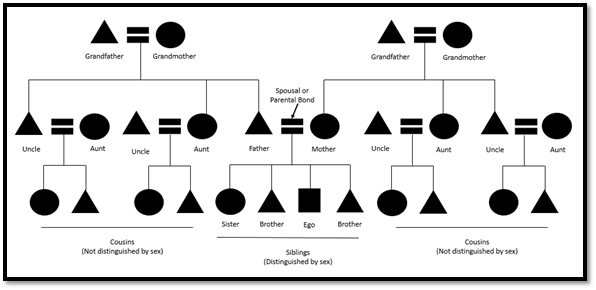Table of Contents
Kinship diagrams
If anthropology had a logo, it might be the symbols used for diagrams that represents people's genealogical relationships, often called kinship diagrams.
For anthropologists, kinship is social, not natural. Yet anthropologists have historically tended to assume that the natural facts of reproduction are the basis for the social categories of kinship. After all, everyone alive was at one point born. A kinship system, in other words, is a set of categories that apply to people who are linked by genealogical ties arising from their parents.
Kinship and genealogy are like the sex–gender distinction, that is,
- Kinship (is to) genealogy (as) gender (is to) sex (as) culture (is to) nature.
In this perspective, in order to talk about one society's kinship classifications, it helps to map them on to the basic genealogical relationships between parents and children.
These diagrams may appear complex but upon closer inspection can easily be deciphered. That is, if you are familiar with a European or Western anthropologist's understanding of genealogy.
An example kinship diagram using the conventional symbols for people and their genealogical relationships (Gilliland 2020, fig. 2) .
What do the symbols mean?
- Circles represent women; triangles represent men. A square is typically used when the gender of the person is not known or is not relevant to the diagram.
- A single solid vertical line represents the relationship of filiation, or a parent–child link.
- A horizontal overbar connecting two or more people is a group of siblings.
- A double horizontal line (like an equals-sign), or an underbar if you want to be fancy, connecting two people is a relationship of marriage
- For that reason, vertical lines tend to descend from a double line to an overbar, indicating that two people, a man and a woman, are the married parents of a group of siblings.
Isn't this supposed to be a system for diagramming alternative forms of family and kinship?
Yes, ideally it is. And if you think about it, using these symbols to identify opposite-sex marriage, parent–child, and sibling links makes a huge ethnocentric assumption. It implies that, while people may have specific kin terms for kinship categories, they are fundamentally connected through heterosexual marriage and two-parent households. (And only have two genders.)
Perhaps for that reason, no two anthropologists make kinship diagrams the same way. This system is common, but it is never followed very strictly. Moreover, diagrams never exist alone. No one claims that they represent an absolute truth about people. For a good anthropologist, they must be complemented with an ethnographic description informed by an emic, insider's perspective.
Reference
Gilliland, Mary Kay. 2020. “Family and Marriage.” In Perspectives: An Open Invitation to Cultural Anthropology, edited by Thomas McIlwraith, Nina Brown, and Laura T. de González, 182–203. Arlington, Va.: American Anthropological Association. https://pressbooks.pub/perspectives/chapter/family-and-marriage/.
Similar pages
- Kinship as social action (50.64%)
- Kinship is culture, not nature (34.46%)
- Kinship as social action (32.21%)
- kinship (92.63)
- marriage (44.22)
- parents (16.71)
- categories (16.36)
- kin (10.59)
- Kinship is culture, not nature (18.88%)
- kinship (42.93)
- siblings (15.76)
- terms (13.02)
- parents (10.02)
- relationships (8.41)
-
- people (43.92)
- they (36.68)
- one (14.92)
- anthropologists (14.26)
- through (14.05)
- Rules as resources (18.5%)

